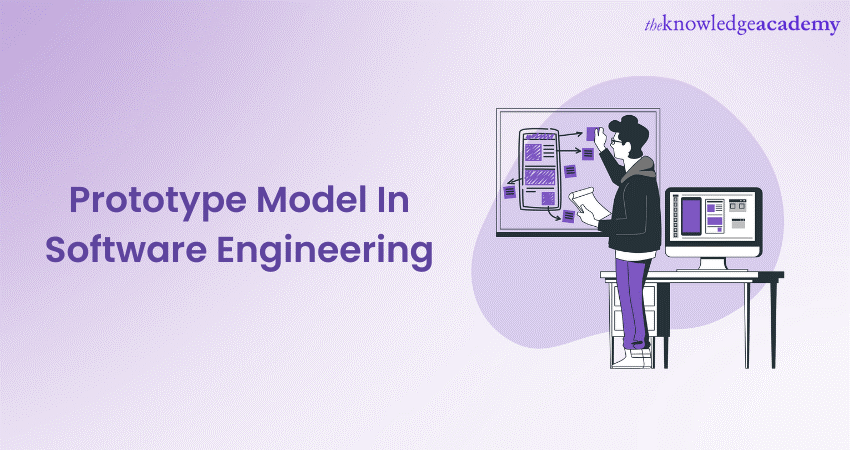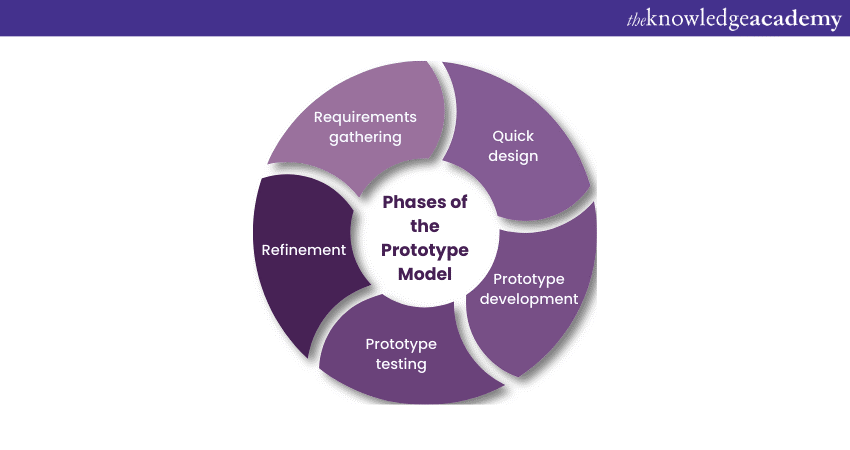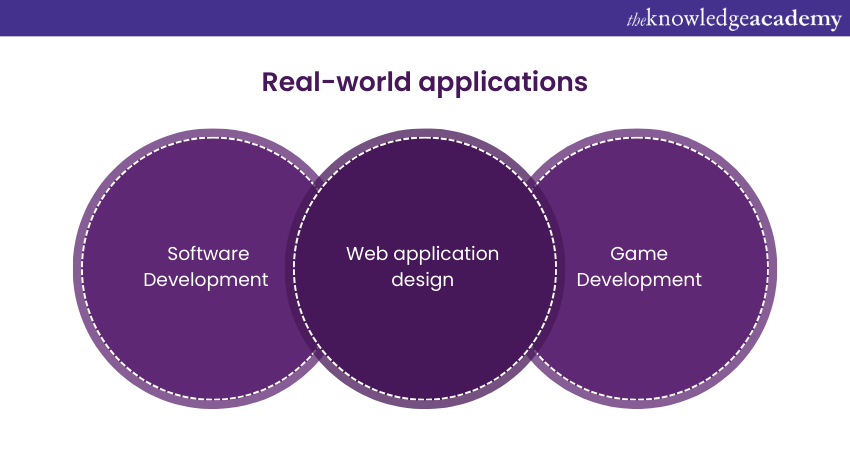We may not have the course you’re looking for. If you enquire or give us a call on 01344203999 and speak to our training experts, we may still be able to help with your training requirements.
We ensure quality, budget-alignment, and timely delivery by our expert instructors.

The Prototype Model in Software Engineering provides a paradigm shift, redefining the traditional approach to development. This innovative methodology involves crafting functional prototypes as dynamic blueprints for software solutions. By placing clients and developers in a symbiotic feedback loop, the Prototype Model propels projects towards higher efficiency and alignment with end-users' needs.
This blog will explore the phases, advantages, challenges, and real-world implications of the Prototype Model in Software Engineering. Let’s dive in to learn more!
Table of Contents
1) What is the Prototype Model in Software Engineering?
2) Types of Prototyping Models
3) Phases of the Prototype Model
4) Advantages of the Prototype Model
5) Challenges of the Prototype Model
6) Real-world applications
7) Comparison with other development models
8) Guidelines for effective prototype development
9) Steps to implement the Prototype Model
10) Conclusion
What is the Prototype Model in Software Engineering?
The Prototype Model is a Software Development approach useful for projects with vague or changing requirements. It involves creating a preliminary version of the software product, called a prototype, that shows the basic features and functionality that the customers want.
The prototype is then tested and improved by the customers and the developers until the customers are happy with the final prototype, which forms the basis for the final product. The Prototype Model has some benefits, such as increasing customer involvement, reducing risks, and improving quality. However, it also has some drawbacks, such as being time-consuming, costly, and hard to document.
Types of Prototyping Models
Prototyping Models are Software Development approaches that involve creating preliminary versions of the software product, called prototypes, that demonstrate the basic features and functionality that the customers want. There are four types of Prototyping Models:
1) Rapid Throwaway Prototyping
This technique offers a valuable method of exploring ideas and getting customer feedback for each of them. In this method, a developed prototype does not necessarily need to be a part of the ultimately accepted prototype. Customer feedback helps prevent unnecessary design faults, so the final prototype developed is of better quality.
The Rapid Throwaway Prototyping technique suits projects with unclear or changing requirements or when the developers want to experiment with different alternatives. The main advantage of this technique is that it allows the developers to identify and eliminate the flaws in the design quickly. The main disadvantage is that it can be wasteful and time-consuming, as the prototype is discarded after each iteration.
2) Evolutionary Prototyping
In this method, the prototype developed initially is incrementally refined based on customer feedback till it finally gets accepted. Compared to Rapid Throwaway Prototyping, Evolutionary Prototyping offers a better approach that saves time and effort. This is because developing a prototype from scratch for every iteration of the process can sometimes frustrate developers.
The Evolutionary Prototyping technique is suitable for projects with stable and well-defined requirements or when the developers want to deliver a working product as soon as possible. The main advantage of this technique is that it allows the developers to improve the quality and functionality of the product over time. The main disadvantage is that it can be challenging to document and maintain as the prototype undergoes
3) Incremental Prototyping
In this type of Incremental, the final expected product is broken into different small pieces of prototypes and developed individually. Ultimately, when all individual pieces are appropriately developed, the various prototypes are collectively merged into a single final product in their predefined order. It’s a very efficient approach that reduces the complexity of the development process, where the goal is divided into sub-parts, and each sub-part is developed individually.
The time interval between the project’s beginning and final delivery is substantially reduced because all system parts are prototyped and tested simultaneously. Of course, there might be the possibility that the pieces just do not fit together due to some lack of ness in the development phase – this can only be fixed by careful and complete plotting of the entire system before prototyping starts.
The Incrementa technique is suitable for projects with modular and independent components or when the developers want to deliver a functional product in stages. The main advantage of this technique is that it allows the developers to focus on one part of the system at a time and get customer feedback. The main disadvantage is that it requires careful and complete planning of the entire system before prototyping starts, as any changes in the requirements or design can affect the integration of the prototypes.
4) Extreme Prototyping
This method is mainly used for Web Development. It consists of three sequential independent phases:
a) A basic prototype with all the existing static pages is presented in Hypertext Markup Language (HTML) format in this phase. This phase is used to create the user interface and navigation of the web application and get feedback from the customers. It allows the developers to design and test the layout and appearance of the web pages quickly. However, a basic prototype does not include any functionality or data processing of the web application.
b) In the second phase, functional screens are made with a simulated data process using a prototype services layer. This phase is used to create the web application's functionality and logic and get customer feedback. The phase allows the developers to quickly implement and test the features and behaviour of the web application, although without any actual data or services of the web application.
c) This is the final step, where all the services are implemented and associated with the final prototype. This phase is used to create the data and services of the web application and integrate them with the user interface and functionality.
This Extreme Prototyping method makes the project cycling and delivery robust and fast. Moreover, it keeps the entire developer team focused and centralised on product deliveries rather than discovering all possible needs and specifications and adding necessitated features. This technique is suitable for projects with web-based and dynamic applications or when the developers want to use an agile and iterative approach to Web Development. The main advantage of this technique is that it allows the developers to rapidly prototype and test the web application and get customer feedback. The main disadvantage is that implementing and integrating all the services with the final prototype can be complex and risky.
Unlock advanced tools in systems with our Systems Modelling Techniques Course. Start enhancing your designs today!
Phases of the Prototype Model
The Prototype Model is characterised by its iterative nature, which allows for the development of a functional prototype followed by continuous refinement based on feedback.

1) Requirements gathering: During this phase, developers engage in in-depth discussions with stakeholders to identify the primary objectives of the software. However, unlike traditional methods, where all requirements are gathered up front, the Prototype Model focuses on capturing the essential features and functionalities that will be incorporated into the initial prototype.
2) Quick design: With the initial requirements in hand, developers create a quick and simplified design of the software's user interface and core functionalities. This design serves as a blueprint for the prototype, outlining the basic layout, user interactions, and essential features. The goal is to establish a foundation that can be built upon in subsequent phases.
3) Prototype development: Based on the quick design, developers begin creating the actual prototype of the software. This prototype is a working model that focuses on demonstrating the core features and functionalities of the software. It might need some of the intricate details and advanced features that would be present in the final product.
4) Prototype testing: Once the prototype is developed, it undergoes testing to identify any issues, bugs, or areas of improvement. This testing phase involves both developers and clients working collaboratively to evaluate the prototype's functionality and user experience. Clients interact with the prototype, providing real-time feedback on its usability and alignment with their requirements.
5) Refinement: Feedback obtained from prototype testing forms the basis for the refinement phase. Developers analyse the feedback and begin making necessary changes and improvements to the prototype.
These changes involve addressing identified issues, adding missing functionalities, and enhancing the user interface. The prototype is iteratively refined based on client feedback, ensuring that it becomes a more accurate representation of the final product with each iteration.
Master the COCOMO Model – Want to improve your software development accuracy? Dive into the COCOMO Model in Software Engineering now!
Advantages of the Prototype Model
The Prototype Model in Software Engineering offers several distinct advantages. It promotes enhanced collaboration between developers and clients, promoting active involvement and feedback throughout development.
Early detection of issues is facilitated by creating a functional prototype, enabling timely identification and resolution of potential problems. The model's inherent flexibility and iterative approach accommodate changing requirements and allow for continual improvements, ensuring that the final product aligns more accurately with client expectations.
The Prototype Model facilitates a deeper understanding of project requirements as developers and clients gain more precise insights into the software's functionalities and design, resulting in a more refined and effective product.
Uncover the secrets of seamless Software Development with our specialised Software Development Lifecycle Training - Sign up Now!
Challenges of the Prototype Model
The flexibility that allows for iterative improvements can also lead to scope creep, where evolving client demands may extend project timelines and increase complexity. Incomplete initial requirements might hinder the effectiveness of the prototype, requiring additional iterations to address client needs fully.
The iterative nature of the model can sometimes lead to time and resource constraints, as multiple refinement cycles may consume more resources than initially planned.
There's a risk of unrealistic expectations, as clients might need to understand the prototype as the final product, potentially leading to disappointment if outcomes differ from prototype functionality or design.
Real-world applications
The Prototype Model finds diverse real-world applications across various domains of Software Development. In Software Development projects, it aids in creating user-centric solutions by iteratively refining functionality and design based on user feedback.

Web application design benefits from prototyping by allowing developers to test and optimize user interfaces and interactions, leading to more intuitive and engaging web experiences. In user interface design, prototypes are tangible visualisations of design concepts, enabling designers to fine-tune layouts and interactions before implementation.
Game Development leverages prototyping to experiment with gameplay mechanics, level designs, and user experiences, ultimately resulting in immersive and captivating games that cater to players' preferences.
Understand COCOMO for Better Estimation – Unlock the power of the COCOMO Model in Software Engineering and refine your software project estimates with this powerful tool.
Comparison with other development models
Different differences emerge when comparing the Prototype Model with other prevalent development methodologies. In contrast to the linear progression of the Waterfall Model, the Prototype Model adopts an iterative approach, facilitating flexibility and responsiveness to changing requirements.
While sharing similarities with Agile regarding iteration, Agile often emphasises delivering functional increments of software in each cycle, while the Prototype Model concentrates on evolving a functional prototype.
The Spiral Model's focus on risk assessment and management diverges from the Prototype Model's emphasis on creating a working model to gather feedback, making the latter particularly suitable for projects requiring continuous user engagement and adaptable development paths.
Boost your systems development skills with the Systems Development Essentials Training. Start building efficient, robust systems today!
Guidelines for effective prototype development
Effective prototype development hinges on several essential guidelines. Clear and open communication with clients ensures their expectations align with the prototype's purpose and capabilities. Prioritising core features in the prototype design allows for a focused demonstration of essential functionality.
Managing stakeholder expectations is crucial, as educating them about the iterative nature of the process helps prevent misconceptions about the prototype's status as a final product. Balancing the number of iterations and available resources is essential to avoid project overruns while maintaining a consistent pace of refinement.
By adhering to these guidelines, developers can maximise the prototype's effectiveness in capturing client needs and shaping the final product.
Steps to implement the Prototype Model
Implementing the Prototype Model involves a series of strategic steps. Firstly, identifying user needs comprehensively provides a solid foundation for prototype development. The initial prototype is created based on these needs, outlining core features and functionalities. Soliciting feedback from stakeholders and users is then vital to gather insights and refine the prototype iteratively.
Incorporating this feedback leads to subsequent rounds of refinement and iteration, progressively aligning the prototype with client expectations and ensuring the product accurately meets desired goals.
This step-by-step approach encapsulates the dynamic and collaborative essence of the Prototype Model, promoting a development process that thrives on continuous improvement and responsive adaptation.
Conclusion
The Prototype Model in Software Engineering is a dynamic catalyst for promoting collaboration, innovation, and adaptability. Through its iterative phases, this model streamlines development by aligning client expectations, detecting issues early, and enhancing flexibility. Embracing it will elevate your projects to new levels of success.
Elevate your skills in software design and architecture with our Software Design and Architecture Training – Sign up today!
Frequently Asked Questions
What is the Prototype Model in Software Engineering?

The Prototype Model in Software Engineering is an iterative development approach where a simplified version of the software is built quickly to showcase functionality and gather feedback from stakeholders. It helps identify requirements, refine designs, and mitigate risks early in the development process.
What is called a prototype?

A prototype is a preliminary version or model of a product, system, or software that is built to demonstrate its functionality, features, and design concepts. It is used to gather feedback, test ideas, and validate requirements before full-scale development.
What are the other resources and offers provided by The Knowledge Academy?

The Knowledge Academy takes global learning to new heights, offering over 3,000 online courses across 490+ locations in 190+ countries. This expansive reach ensures accessibility and convenience for learners worldwide.
Alongside our diverse Online Course Catalogue, encompassing 19 major categories, we go the extra mile by providing a plethora of free educational Online Resources like News updates, Blogs, videos, webinars, and interview questions. Tailoring learning experiences further, professionals can maximise value with customisable Course Bundles of TKA.
What is the Knowledge Pass, and how does it work?

The Knowledge Academy’s Knowledge Pass, a prepaid voucher, adds another layer of flexibility, allowing course bookings over a 12-month period. Join us on a journey where education knows no bounds.
What are the related courses and blogs provided by The Knowledge Academy?

Explore Software Engineering Courses with The Knowledge Academy, where more courses await, including Software Development Lifecycle Training, Systems Engineering Training and Agile Software Development Training. Tailored for various skill levels, these courses offer in-depth insights into the Importance of Software Engineering.
Dive into our Programming and DevOps Blogs, a trove of resources covering Software Engineering topics. Whether you are a beginner or aiming to enhance your Software Engineering skills, The Knowledge Academy's diverse courses and insightful blogs are your go-to source.






 Top Rated Course
Top Rated Course




 If you wish to make any changes to your course, please
If you wish to make any changes to your course, please


